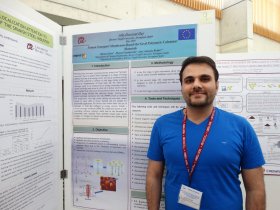Alireza Zare

PhD Programme: Nanoscience, Materials and Chemical Engineering
Research group: MEMTEC – Materials, Membrane and Encapsulation Technology
Supervisors: Marta Giamberini & José Antonio Reina Lozano
Bio
Alireza Zare graduated in Chemistry at Amirkabir University of Technology (AUT) of Tehran, Iran. His thesis was titled "Synthesis of polyimide/functionalized graphene-ionic liquid Nano composite membranes and synthesis of polyimide/sulfonated hyperbranched polyimide for using in polymer membrane fuel cells". Alireza worked as a research assistant in the Central Laboratory at the AmirKabir University of Technology. He contributed to several research projects.
Project: Novel polymeric membrane for artificial photosynthesis
This doctoral thesis focuses on preparing novel polymeric membranes to be used in artificial photosynthesis devices. In particular, we are interested in membranes for both ion conductive and CO2 capture. We prepared and characterized two different materials, based on Poly(epichlorohydrin-co-ethylene oxide) (PECH-co-EO) grafted with potassium 3,4,5-tris[4-(n-dodecan-1-yloxy)benzyloxy] benzoate, containing 20% (CP20) or 40% (CP40) modified units, respectively. In order to reach efficient transport properties, homeotropically oriented membranes were prepared by a fine-tuned thermal annealing treatment and were subsequently investigated by dynamic mechanical thermal analysis (DMTA) and dielectric thermal analysis (DETA). DMTA and DETA confirmed that grafting with the dendron strongly hinders copolymer motions, but did not show great differences between unoriented and oriented membranes, regardless of the amount of dendrons. Moreover, transport properties were studied by methanol and proton conductivity experiment and by linear sweep voltammetry (LSV). Results demonstrated that in CP20 and CP40, cation transport depends on the presence of defined cationic channels, not affected by water presence; the comparison between LSV experiments performed with different alkaline cations suggests that CP40 possesses channels with larger diameters and better-defined inner structures. We focused on improving CO2 absorption performance by using two different additives in neat polysulfone as gas-liquid membrane contactors. These additives are amine additives based on hyperbranched Lupasol G20 partially grafted with benzoyl chloride (mG20) or phenyl isocyanate (UG20). Membranes with different amount of additives were prepared by phase inversion precipitation and characterized by several techniques. In general, it was found that the presence of the additive greatly improved the characteristics of the membranes as regards the CO2 capture, especially solubility, hydrophobicity and chemical resistance to the aqueous alkaline absorbent solution, giving the better results for 5% additive content. In summary, the performance of blend membranes in terms of CO2 permeability and absorption was improved by both additives, while UG20 demonstrates better performance compared to mG20.
Open Access publications
- Zare A, Perna L, Nogalska A, Ambrogi V, Cerruti P, Tylkowski B, García-Valls R, Giamberini M. Polymer Blends for Improved CO2 Capture Membranes. Polymers (Basel). 2019 Oct 12;11(10):1662. View full-text
- Zare, Alireza, Borja Pascual-Jose, Silvia De la Flor, Amparo Ribes-Greus, Xavier Montané, José A. Reina, and Marta Giamberini. 2021. "Membranes for Cation Transport Based on Dendronized Poly(epichlorohydrin-co-ethylene oxide). Part 1: The Effect of Dendron Amount and Column Orientation on Copolymer Mobility" Polymers 13, no. 20: 3532. View full-text
- Zare, Alireza, Xavier Montané, José A. Reina, and Marta Giamberini. 2021. "Membranes for Cation Transport Based on Dendronized Poly(Epichlorohydrin-Co-Ethylene Oxide). Part 2: Membrane Characterization and Transport Properties" Polymers 13, no. 22: 3915. View full-text
- PHD THESIS: Novel polymeric membrane for artificial photosynthesis
Outreach activities
- European Researchers’ Night 2020: “Chemistry to understand coronavirus”.
International secondment
- Consiglio Nazionale delle Ricerche, Italy. 1 month (2022).



